Nina Allender's Suffrage Cartoons
-
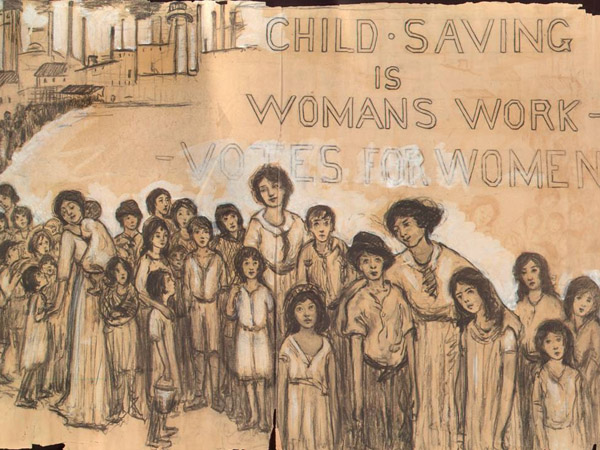 Image courtesy Sewall-Belmont House & Museum, Washington, D.C.
Image courtesy Sewall-Belmont House & Museum, Washington, D.C.To commemorate the anniversary of women's suffrage, check out this gallery of cartoons drawn by propagandist Nina Allender to advocate for the vote.
Child Saving Is Woman’s Work: July 25, 1914
Allender’s earlier cartoons focused on how a woman’s vote could help create protective labor legislation for child workers. Women, she reminded politicians, were the ones who could save juvenile factory workers from these unjust conditions. The Fair Labor Standards Act, which regulated child labor, was passed in 1938.
Return to the XX Factor post about Nina Allender.
-
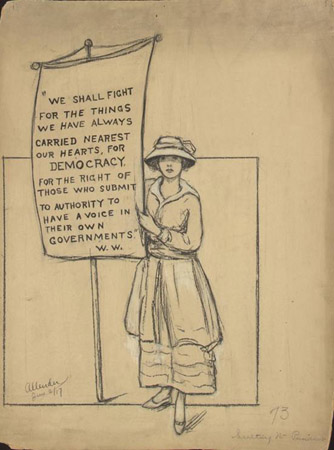 Image courtesy Sewall-Belmont House & Museum, Washington, D.C.
Image courtesy Sewall-Belmont House & Museum, Washington, D.C.Insulting the President: June 2, 1917
Picketing in front of the White House for the right to vote began in January 1917, and demonstrations were relatively peaceful for the first six months. But the tone changed when President Woodrow Wilson entered the country into World War I. Women, enraged by the laughable hypocrisy of men fighting for democracy abroad while their wives, sisters, and mothers battled for their rights in the so-called land of the free, introduced an element of antagonism to their campaign. In this image, Allender shows a burgeoning trend of “insulting the president,” or pulling lines from his speeches to illustrate the gap between the president’s treatment of women and his stated beliefs.
-
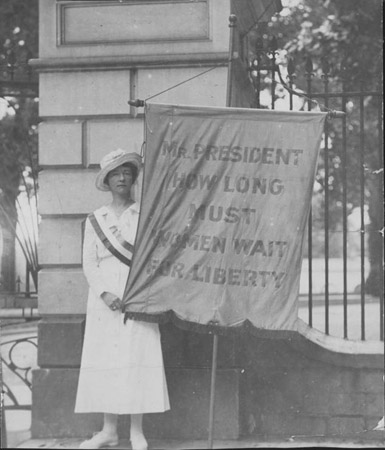 Image courtesy Sewall-Belmont House & Museum, Washington, D.C.
Image courtesy Sewall-Belmont House & Museum, Washington, D.C.At the White House Gates: June, 1917
New Yorker Elizabeth Colt was a regular picketer. She’s pictured here just weeks before the police began arresting demonstrators.
-
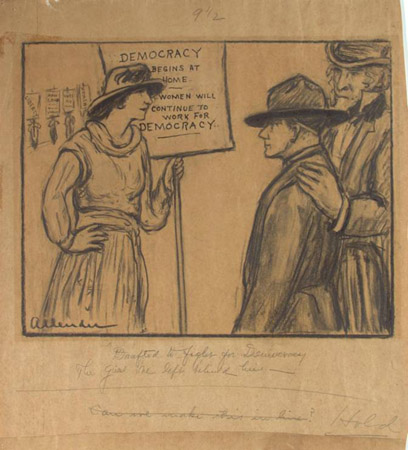 Image courtesy Sewall-Belmont House & Museum, Washington, D.C.
Image courtesy Sewall-Belmont House & Museum, Washington, D.C.The Girl He Left Behind Him: Sept. 1, 1917
Allender depicts a woman, her hand on her hip, confronting Uncle Sam and a soldier. The message: How can American soldiers fight for democracy overseas while American women still don’t have full rights at home?
-
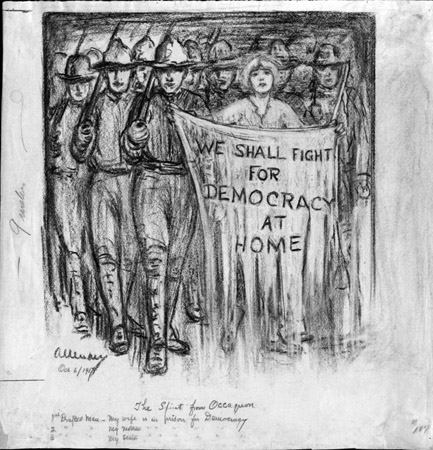 Image courtesy Sewall-Belmont House & Museum, Washington, D.C.
Image courtesy Sewall-Belmont House & Museum, Washington, D.C.We Shall Fight for Democracy at Home: Oct. 6, 1917
Officials were beginning to lock away suffragists like Lucy Burns in the Occoquan workhouse in Virginia at the time Allender drew this picture. Her notes below the image read: “1st drafted man, my wife is in prison for democracy, 2nd drafted man, my mother is in prison for democracy, 3rd drafted man, my sister is in prison for democracy.” The woman’s fight, Allender shows us, is intertwined with the soldier’s. The frayed banner represents the literal destruction of banners outside the White House and the abuse picketers endured.
-
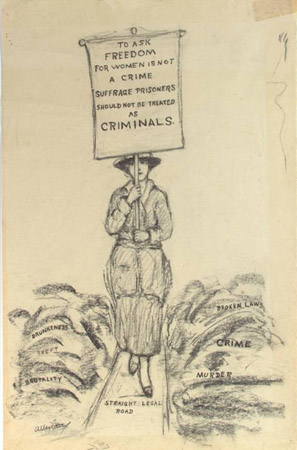 Image courtesy Sewall-Belmont House & Museum, Washington, D.C.
Image courtesy Sewall-Belmont House & Museum, Washington, D.C.To Ask Freedom for Women Is Not a Crime: Nov. 17, 1917
Picketers should not be treated as common criminals, Allender says here, responding to the suffragists who had been brutally attacked during the Night of Terror at Occoquan prison, a particularly grisly showdown between suffragists and police on Nov. 15. Here, she depicts a woman walking down the “straight legal road.”
-
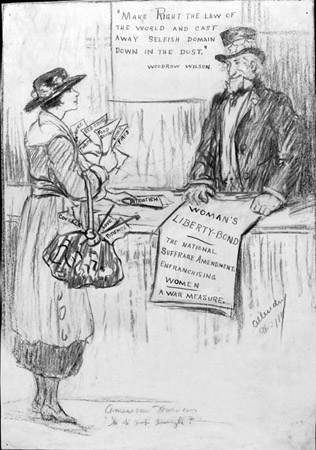 Image courtesy Sewall-Belmont House & Museum, Washington, D.C.
Image courtesy Sewall-Belmont House & Museum, Washington, D.C.American Women: “Is It Not Enough?”: April 27, 1918
This Allender girl advocates for the woman’s vote to be passed as a war measure. At the time, the government sold liberty bonds to fund the war effort; this woman presents the woman’s liberty bond to Uncle Sam in the form of a federal suffrage amendment.
-
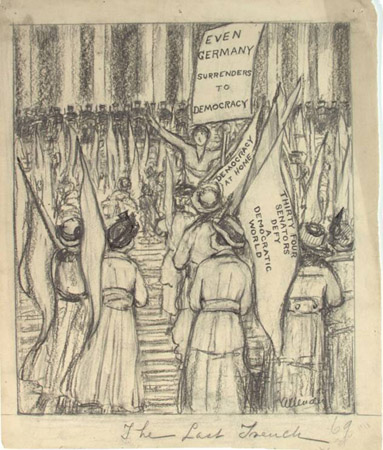 Image courtesy Sewall-Belmont House & Museum, Washington, D.C.
Image courtesy Sewall-Belmont House & Museum, Washington, D.C.The Last Trench: Oct. 26, 1918
Here, women protest on the steps of the U.S. Capitol, the final frontier of their rights battle. Their goal: convince Congress to pass the 19th Amendment. Again, Allender illuminates the hypocrisy of the situation by drawing soldiers in the background.
-
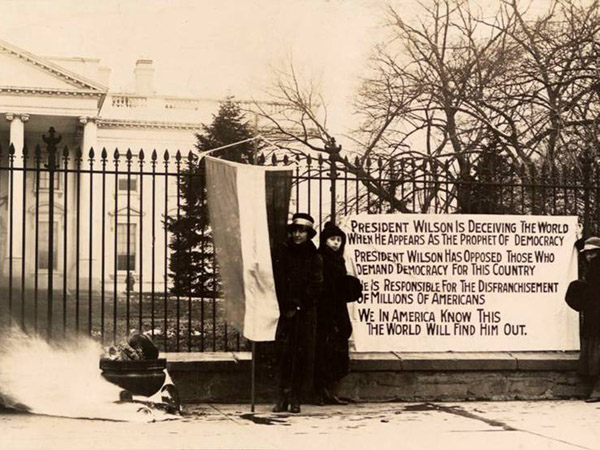 Image courtesy Sewall-Belmont House & Museum, Washington, D.C.
Image courtesy Sewall-Belmont House & Museum, Washington, D.C.Fighting With Fire: Jan. 1919
While it’s not an Allender cartoon, this photograph captures a strikingly ferocious sliver of the movement: In early 1919, picketers dragged urns to the front of the White House and burned President Wilson’s speeches after reading them. (Notice the billowing smoke on the left.) In this image, one of the picketers props up the purple, white, and gold National Women’s Party banner: Purple stood for the glory of womanhood, white for purity in home and politics, and gold for the crown of victory.
-
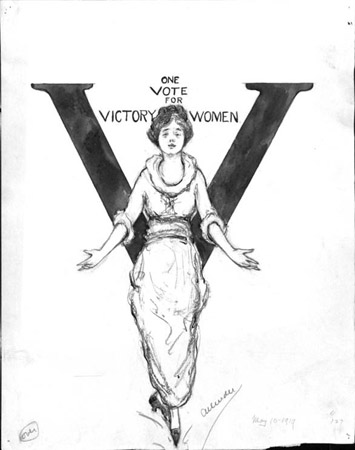 Image courtesy Sewall-Belmont House & Museum, Washington, D.C.
Image courtesy Sewall-Belmont House & Museum, Washington, D.C.Victory: May 10, 1919
Allender created this iconic image 11 days before the House of Representatives passed the 19th Amendment. The Senate passed it two weeks later, and the secretary of state certified its ratification on Aug. 26, 1920.
Return to the XX Factor post about Nina Allender.